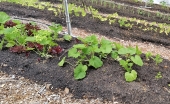





Pete Podurgiel wrote: one item you might consider adding to your list is sunflower seeds. I've had mixed results with them though, mostly to do with the seed husks clinging to the sprouts (along with some soil) and made for a difficult harvest.
Riona Abhainn wrote:How much does it scale up your electric bill?
 But I calculated it is about $1 dollar a day depending on electricity rate to run the 8x42w LED lights for 16 hours a day. So even one big salad a week would break even which is more than doable.
But I calculated it is about $1 dollar a day depending on electricity rate to run the 8x42w LED lights for 16 hours a day. So even one big salad a week would break even which is more than doable.
James MacKenzie wrote:If you grow your peppers in pots you can bring them in and overwinter them quite successfully.
cheers!
Anne Miller wrote: You mentioned pea, did you get any peas to produce?





Anne Miller wrote:
We mix the composted cow manure directly into the soil for 6 to 8 inches.
.
May Lotito wrote:For the peas and beans, do you apply some inoculant of nitrogen fixing bacteria? They can take a while to develop relationship with legumes if the composted manure has little in it.